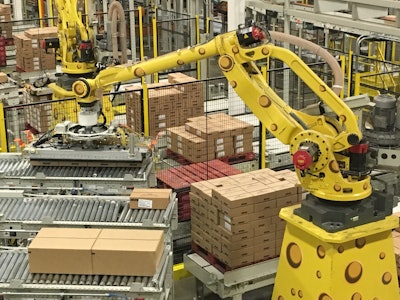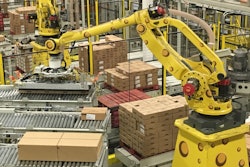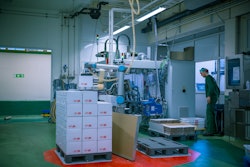Sargento Foods Inc. has been running a centralized palletizing system at its plant in Plymouth, WI, for almost two years. Installed in phases with completion in 2014, the system was implemented to replace manual palletizing on multiple production lines producing sliced, snack, and shredded natural cheese products. Although primarily handling products for the retail market, the system also supports foodservice and industrial customers as well as some club-store applications.
Due to space limitations within the facility, the centralized palletizing concept was the most practical option. Requirements for the system included a neutral to positive return on cost of goods sold, a reduction in the forklift traffic around the production lines, improvements in the quality of work, especially ergonomics, and the installation of a robust and reliable system.
After competitive analysis, which included a number of qualified vendors, Sargento selected Intelligrated Systems to design and implement the system. According to Barry Blatz, Sargento Senior Project Engineer for the project, Intelligrated offered the best combination of self-manufactured conveyor components, Fanuc robotics, large-system experience, and in-house controls integration.
During operation of the system, after cases are filled with product on each production line, they are sealed and labeled with a 128-style UPC code. They are then carried away from the production line by elevated conveyors to an overhead level and introduced to high-speed trunk-line conveyors. These conveyors further combine cases into a single file as they travel—up to to 700 feet, in some cases—to the central palletizing area.
Once there, the UPC code on the case is read as the case enters the central palletizing area. Based on the product and the line on which it was produced, each case is conveyed to one of eight palletizing cells and diverted into one of three palletizing lanes. A Fanuc M-410iB robot within each cell uses a vacuum plenum end-of-arm tool to palletize according to a pattern developed by using Intelligrated programming within the Fanuc software. Each robotic cell has the capability to manage up to three production lines, depending on the type of case, pallet pattern, and cases per minute. Just for fun, the robots were aptly decorated with Swiss-hole decals to “cheesify” them.
After each pallet is finished, it is transferred from the cell via a transfer car and sent to automated warehousing. While on its way, the pallet is automatically stretch-wrapped by a Wulftec WCRT-200 automatic rotary-arm stretch wrapper and is given a pallet license plate containing all necessary product information.
The Intelligrated-developed control system is based largely on Allen-Bradley components, including 87 ArmorStart® controllers, five ControlLogix® Safety PLCs, 20 MicroLogix™ ML 1100 PLCs, and 45 Variable Frequency Drives. Additionally, the system is network-based with three separate networks connecting all of the above with over 800 photoeyes or proximity switches, 189 motor-driven rollers, 10 operator touchscreens, five device-level rings, and high-speed UPC scanners using 357 IP addresses.
According to Sargento Robotics Engineer Brijesh Mohan, the system has proven very robust and dependable since the initial network configurations and traffic were fully commissioned. He adds that IntraVUE Ethernet software has been a valuable tool for verification and monitoring of this large network.
In fact, says Mohan, the entire Intelligrated palletizing system has demonstrated high reliability. When parts are needed, Intelligrated offers a 24/7 online parts ordering system. Fanuc robotics have also demonstrated high reliability and are on OEM preventive service.
According to Sargento system operators, the biggest issues with running this large palletizing system are related to the simplest components: wood pallets and corrugated cases. Pallets are inspected prior to being introduced into the system. Even so, occasionally a loose or missing board will cause a jam or stoppage within the system. Case gluing/taping is highly reliable, but on rare occasions, a flap may be left open. In both of these issues, the system will shut down and alert an operator of a fault. The operator can then initiate proper safety lockouts, enter the robotic cell, and correct the issue. In case of an extended issue, cases can be diverted to an area for hand-palletizing. To assist operators keep track of the cases in transport and the palletizing areas, eight cameras provide feedback at an operator area.






























